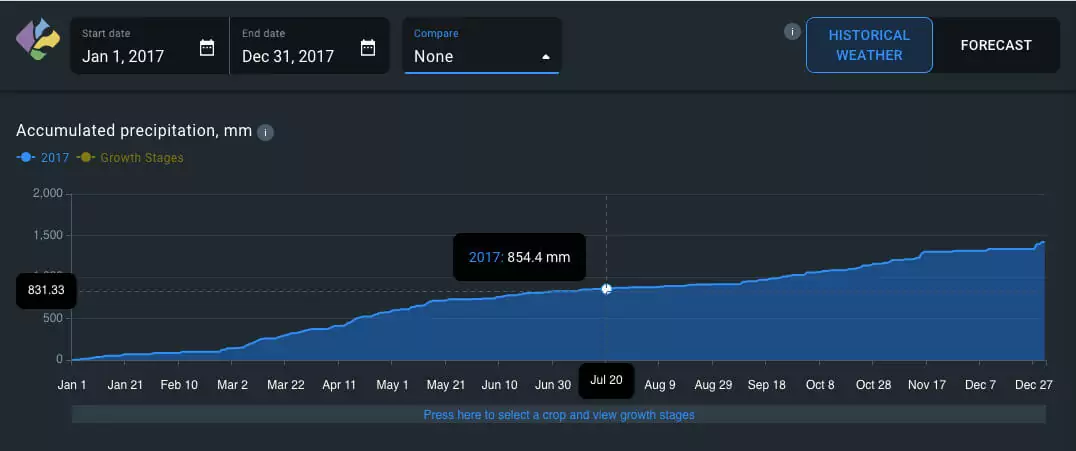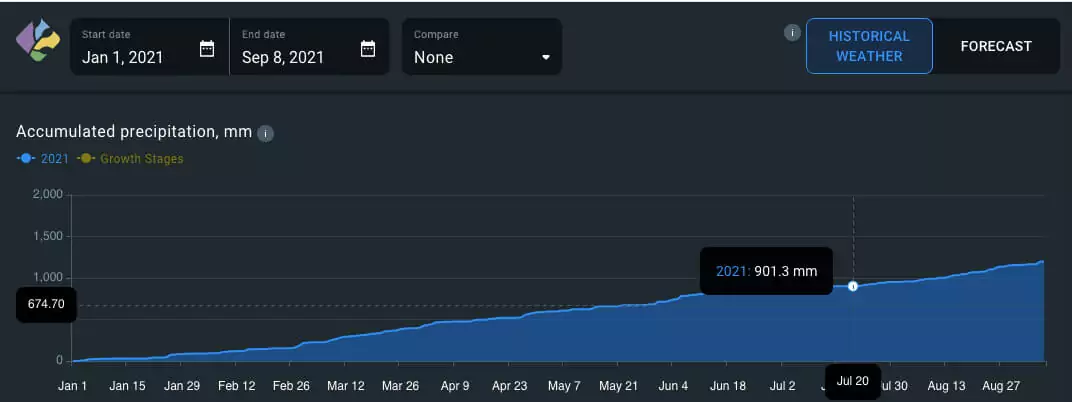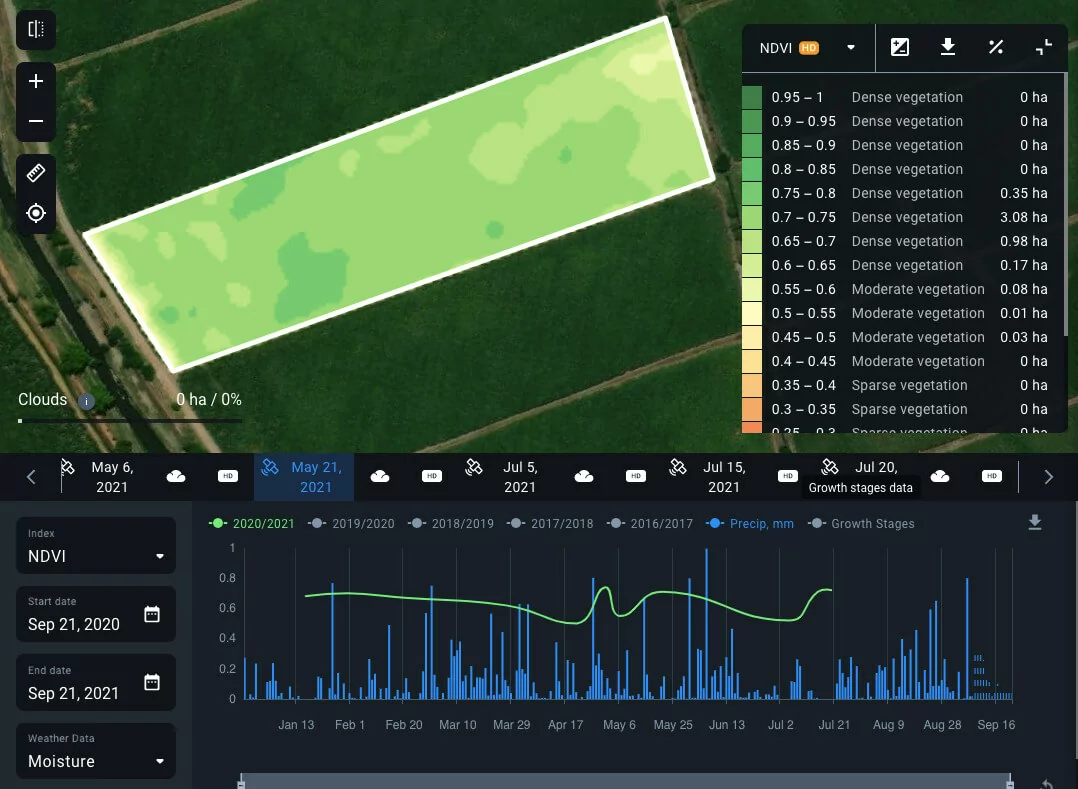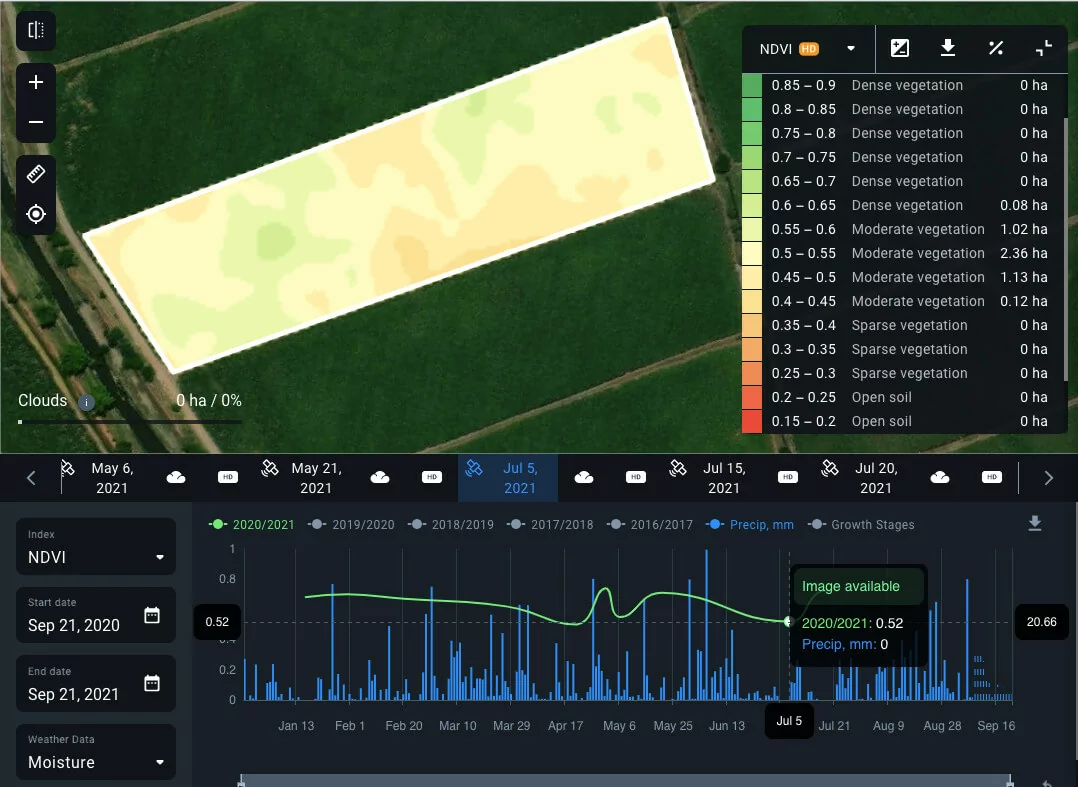
Remote Sensing To Face Ag Risks Due To Climate Change
Climate change and global warming cause abrupt changes in weather patterns that threaten crop yields. Because such changes are hard to predict using traditional predictive models, it affects not only farmers but also the agriculture insurance market. This creates a demand for more precise risk estimation and damage assessment solutions.
Wiingou has recently incorporated the EOSDA Crop Monitoring tool into its business ecosystem. Read on to learn how EOSDA Crop Monitoring improves Wiingou’s forecasting and analytics.
Overview: About Wiingou
Wiingou is a climate risk management consultant operating globally since 2020, with headquarters in France. It works in the agricultural and financial sectors advising farmers, cooperatives, and agro holdings on parametric (index-based) insurance. The company aims at mitigating farmers’ weather-related risks with remote sensing technology and comprehensive analytics, enabling precision agriculture solutions. For financial institutions, Wiingou helps with assessing the risks while lending loans to agribusiness.

Problem: Climate Change And Its Impact On Farming
The agricultural business is extremely sensitive to weather as much depends on getting high yields. Currently, farmers suffer from tremendous losses due to hail, continuous downpours and consequent waterlogging, droughts, cold spells and dry spells, abnormal temperatures, storms, wildfires, and other extreme crop-damaging events. Such unfavorable changes in weather patterns are largely attributed to accelerating climate change and global warming.
Agriculture inadvertently contributes to climate change and, at the same time, is negatively affected by it. Indeed, the Economic Research Service of the US Department of Agriculture (ERS USDA) has assessed the farming share of greenhouse gas emissions in 2018 has increased up to nearly 700 million metric tons. Conversely, global agricultural productivity has dropped due to climate change by 21% since 1961, and for Latin America, Africa, and the Caribbean region the percentage of productivity drop is even higher.
What is more problematic, insurance companies find it progressively harder to generate risk profiles of their clients due to ever-changing weather patterns.
Insurance agents require ever more information and resources to assess field productivity and possible risks related to each specific field for the coverage period. They need the most accurate data to understand exactly what insurance package and compensation amount to apply in each particular case, as well as to determine whether making a deal with the client is reasonable in the first place.
It is essential for both insurers and farmers to be timely aware of the upcoming weather. While it is extremely hard to predict abrupt weather changes triggered by climate change using traditional methods, satellite-based analytics and machine learning are up for the challenge.
Fields analytics tool with access to high-resolution satellite images for remote problem areas identification!EOSDA Crop Monitoring
Solution: Ongoing Field Monitoring & Historical Weather Data
Partnering with EOSDA, Wiingou analyzes historical weather patterns to generate forecasts with more precision. To make predictions, the company’s experts find out similar weather patterns in previous years for the period they want to forecast and create simulations. Using EOSDA Crop Monitoring data for cross-analysis further increases the precision of forecasts.
Combined with our expertise and technologies, Wiingou continues on its mission to help farmers all around the globe to withstand and overcome extreme weather events, making them stronger in the face of climate change risks. Knowledge is power. Armed with data on the probability and quantity of rain during specific periods of the year, farmers will be able to improve planning activities and mitigate risks more successfully.
In the past, extreme unexpected weather events have led to loss of yield and profit. For instance, prolonged dry spells recently affected South African farmers so much that it has nearly ruined their businesses. Similarly, heavy rains, floods, and hail have destroyed a large number of grape crops in the region of Pays de la Loire in France. Using our precision agriculture platform, Wingou analysts will help farmers and insurers to predict destructive weather events and estimate loan risks with more precision.


Cooperation with EOSDA enables Wiingou to forecast weather extremes and remotely assess crop volume and damage.
Historical Weather To Estimate The Probability And Severity Of Extreme Events
Historical weather archives on EOSDA Crop Monitoring allow tracking meteorological trends and predict possible scenarios based on event similarities in the past. The benefits from such insights are multifold. By analyzing numerous factors like precipitation quantity and frequency, temperature patterns, thermal anomalies, their duration, etc. and comparing them with current meteorological trends, it is possible to:
- make weather forecasts;
- predict weather impacts on yields;
- estimate losses.
The list of meteorological data on the EOSDA Crop Monitoring tool is quite extensive and also available through agriculture weather API:
- historical weather data since 2008,
- 9*9 km grid air temperatures,
- humidity,
- wind speed,
- precipitation,
- cold and heat stress,
- evapotranspiration.

Apart from weather analytics, EOSDA Crop Monitoring users can get other valuable insights, also available through API:
- vegetation indices, including NDVI and 17 more;
- satellite imagery and statistics from Sentinel 10 m since 2015, Landsat-8 30 m since 2013, AgroSat 3 m since 2022;
- high-resolution Soil Moisture data 250*250 m from the SMAP, AMSR-E, AMSR-2 sensors since 2002;
- Vegetation and Productivity maps for Variable-Rate Fertilizer Rates (VRA).
Ongoing Field Monitoring For Remote Damage Assessment
Satellite technologies, convenient API access, and an impressive array of features make EOSDA Crop Monitoring an indispensable tool for monitoring crops on a field-level in near-real time. The platform is equipped with a stack of vegetation indices (NDVI, MSAVI, NDMI, among others). These indices can be used to assess the state of vegetation on the field, productivity of the given field, water stress, and other parameters. EOSDA Crop Monitoring also provides users with a 14-day weather forecast and offers an extensive historical data archive dating back to 2008. Thanks to the data on 5-year average precipitation and daily temperatures, farmers and insurers can make better-informed decisions to avoid damage due to extreme weather events. You don’t need to be physically present in the field to gather all this data!


EOSDA Crop Monitoring is not a platform for farmers only. Data that we provide through API can be successfully applied to solve a variety of agribusiness insurance challenges:
- crop state assessment;
- crop location during the sales season;
- recovery of damage by drought;
- information on the harvesting date;
- frost damage estimation and indemnification;
- facilitated field data collection with statistics and analytical tools (e.g., ordering and printing reports) and more upon request.
Outcome: Predict And Mitigate Risks
Accurate historical weather analytics allows estimating potential threats to the crops and treating an insurance case with all the available data taken into consideration. It is ultimately important for the insurers to correctly make a risk profile for adequate coverage. On the one hand, insurance companies try to avoid excessive payouts, on the other hand, their offers should be attractive enough for the clients to want to make a deal.
Assessing the field quality in the long run (based on its productivity for previous years), along with possible upcoming weather trends, insurance agents can decide on the coverage for each particular client. Thus, insurers will understand how to correlate premium rates with payout amounts if an insurance claim occurs.
Apart from weather risk modeling and prediction in agriculture, Wiingou leverages our platform as an added value for its clients. This way all business stakeholders can conveniently access the required data in one place. Please, contact us via sales@eosda.com, if you have any questions.
About the author:
Kateryna Sergieieva has a Ph.D. in information technologies and 15 years of experience in remote sensing. She is a Senior Scientist at EOSDA responsible for developing technologies for satellite monitoring and surface feature change detection. Kateryna is an author of over 60 scientific publications.
Recent articles

Analyze 2025 & Plan Your Best Year Yet: LandViewer Christmas Offer
It’s the most wonderful time of the year! The Christmas holidays are here, and so is your chance to analyze 2025 and plan a prosperous 2026 with more affordable Pro plans in LandViewer.

EOSDA Models Climate Change Impact On Sugarcane Yields
EOSDA modeled future temperature, rainfall, and other climate impacts on Veracruz sugarcane. The results help growers plan long-term adaptation strategies, including timing, varieties, and irrigation.

EOSDA LandViewer Black Friday Sale: Exclusive Offers & Giveaway
This Black Friday, LandViewer offers new users the chance to save on monthly plans, get extra months with yearly subscriptions, and participate in a free annual plan giveaway.